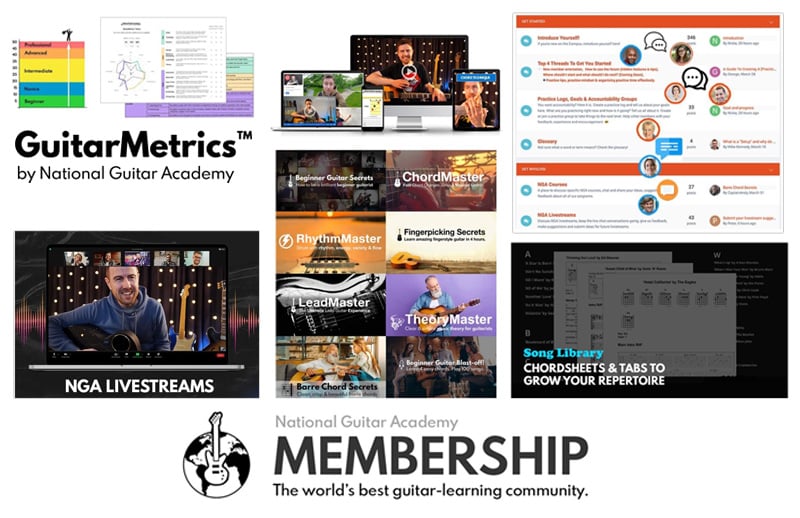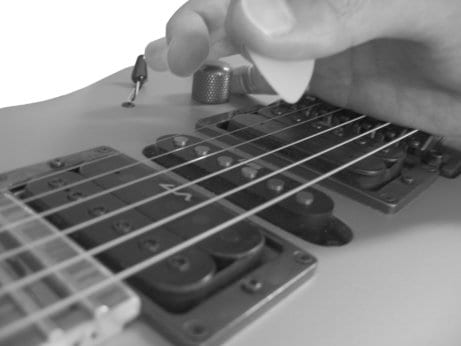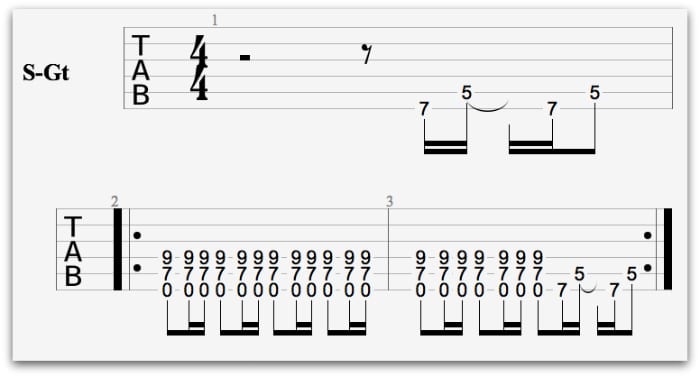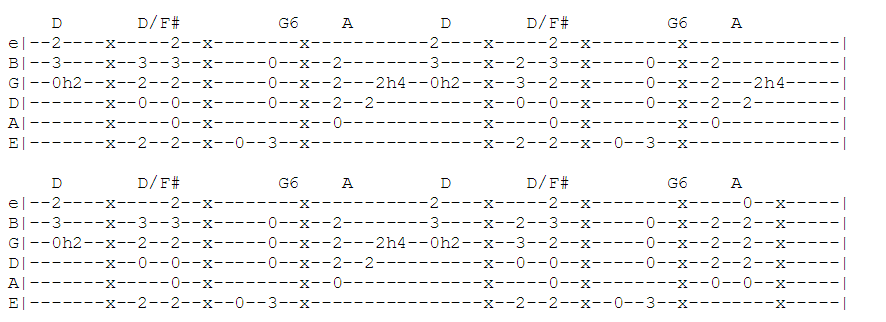Want to learn how to palm mute? You’re in the right place, we’re going to show you EVERYTHING you need to know about palm muting.
In this free guitar lesson you will learn:
- How to palm mute on acoustic and electric guitar.
- The secret to making your guitar sound HUGE.
- 2 quick & easy tips that enhance musicality.
- 6 epic guitar tabs which will make you sound amazing.
Over 100,000 guitar-learners get our world-class guitar tips & tutorials sent straight to their inbox: Click here to join them
If you want to enhance your musicality you MUST know how to palm mute. Learning how to palm mute is a great way of creating a percussive sound on your guitar.
What is palm muting?
Palm muting is used to dampen the strings. The goal of palm muting is to silence the strings to create a rhythmic effect,
This technique can be played on acoustic and electric. However, the techniques are different on each instrument.
On electric guitar:
- Palm muting is used to make guitar chords sound chunky. Palm muting can often be heard in rock and metal music.
On acoustic guitar:
- Palm muting technique is used to add percussion to chords. This technique is often heard acoustic music.
Palm Muting On Electric Guitar
We’re going to show you how to palm mute on an electric guitar in 3 quick & easy steps.
Step #1 Place the side of your hand as close to the bridge as possible
When you how to palm mute, you must use the side of your hand.
Place the side of your hand as close to the bridge as you can. When you palm mute, the notes should have some sustain. You don’t want to completely mute the chord.
Your hand should look like this:
Step #2 Lightly rest your hand on top of the strings
When you palm mute, make sure that you lightly rest your hand on top of the strings. If you put too much pressure on, the chord will NOT sound good.
This is not the effect we’re going for.
Step #3 Pick The Strings
When you pick the strings, make sure that you keep your hand on the bridge while you pick. Your hand must not come away the bridge, it HAS to stay there while you strum.
What chords should I use?
This techniques works with ANY chord. However, when you palm mute sure that you use the lowest 3 strings.
Those strings are:
- The low E string. (6th string.)
- The A string. (5th string.)
- The D string. (4th string.)
These strings will give you the most power when strumming.
✅ Stop struggling. Start making music. ✅ Learn beginner-friendly versions of every chord. This is our most popular guide and it will improve your chord ability quickly! 😎 Get a custom guitar-learning plan here: Click here for GuitarMetrics™ Learn from the world's best guitar educators: Click here for our guitar coursesLearn 12 EASY beginner chords with our popular guide


Where should we send it?
Get your own personalised guitar-learning plan 🎸
World-Class Guitar Courses 🌎
The Secret To Making Your Chords Sound Huge
Once you’ve mastered palm muting, you must learn how to set up your guitar amp. Setting up your guitar amp correctly is crucial to making your guitar chords sound huge.
It doesn’t matter how good your palm muting technique is if your amp isn’t set up right.
Here are a few classic examples of how you can set up your guitar amp to make your palm muting sound huge!
Amp Tone #1
Make sure you crank up the gain, mids and treble. This will make you cut through the mix. Turn your guitar up loud to feel the roar of the amplifier!
Amp Tone #2
This setting has much more gain than. We’ve also added a bit more bass to add some low-end chug to your guitar sound.
Quick Tip!
There are no rules to how you set up your guitar amp. Experiment with your amp and find what’s best for YOU.
Our amp settings will get you in the ball park of a great guitar tone, but feel free to tweak your amp until you get the perfect sound.
Killer Electric Palm Muting Examples
The best way to learn how to palm mute is to listen and learn music which features LOTS of palm muting.
Here are a few classic examples of some songs which use palm muting.
Download our lead guitar cheat-sheet to make things easier
It's hard to understand which scales work with which keys.
So we created a cheat-sheet! A key and scale-finder that you can use again and again.

Get your personalised guitar-learning plan 🎸
Get a custom guitar-learning plan here: Click here for GuitarMetrics™
World-Class Guitar Courses 🌎
Learn from the world's best guitar educators: Click here for our guitar courses
‘Whole Lotta Love’ by Led Zeppelin
This iconic rock riff is one of the first examples of palm muting used in popular music.
Check out the huge sounding opening riff. This riff wouldn’t be half as good without the use of palm muting.
To learn the riff to this song, check out this tab:
‘Basket Case’ by Green Day
Palm muting is widely used in punk music. Green Day demonstrate this excellently in their song ‘basket case’.
Check it out here:
Here’s the tab for the opening riff:
Learn the full song here: Basket Case Tab
‘Master of Puppets’ by Metallica
For an extreme example of palm muting check out ‘master of puppets’ by metallica. Metallica really took palm muting to the next level!
You can learn to play this song on the Ultimate Guitar website, check it out here: Master Of Puppets Tab
Now we’ve covered how to palm mute on electric guitar let’s learn how to do this on an acoustic.
How To Palm Mute On An Acoustic
Palming muting an acoustic is a different affair to palm muting on an electric.
When you palm mute on an electric guitar, you place your strumming hand on the bridge and strum the strings to create a muted sound.
On acoustic, you don’t do this. You strum a chord, and use the palm of your hand within your strumming pattern to create a percussive sound.
Let’s learn how to palm mute on an acoustic.
Step 1) Pluck the strings with your fingers
Most of the time when you palm mute on acoustic, you will be using your fingers to pluck the strings.
When finger picking use your:
- Thumb on either low E string (6th string), A string (5th string) or D string. (4th string.)
Your thumb placement depends on the root note of the chord.
For example, if the root note is on the E string: Put your thumb on the low E string. (6th string.)
If the root note of the chord is on the A string, put your thumb on the A string. (5th string.)
If the root note of the chord is on the D string, put your thumb on the D string. (4th string.)
Learn about root notes here:Guitar Notes Explained: A Guide For Beginners
Where do I put the rest of my fingers?
Once you’ve worked out where to put your thumb, place your:
- 1st finger on the G string. (3rd string.)
- 2nd finger on the B string. (2nd string.)
- 3rd finger on the high E string. (1st string.)
To learn more about finger picking, go here: Fingerstyle Guitar Lessons – 5 Easy Ways To Sound Amazing
Step 2) Strum The Chord
When strumming the chord with your fingers, you have two options. You can either:
- Pluck ALL of the strings simultaneously.
- Finger pick each string separately.
Neither of these options are right or wrong. It’s up to you as a guitarist! Be creative and artistic.
Step 3) Mute The Chord With Your Palm
Once you’ve plucked the chord. Immediately mute it with the fleshy part of your hand. Your hand should be in the shape of a claw and your finger nails should connect with the guitar body.
This creates a percussive sound and sounds fantastic on an acoustic guitar.
Watch this video by Mike where he explains how to do this technique in more detail:
When can I use this technique?
When you use this technique, place the mute on the strong beats of the bar.
Most music is in 4/4 time, so the strong beats in this case are beats 2 & 4.
If you were strumming, you would place your palm mute on beats 2 & 4. Like this:
There is NO hard and fast rule where you can place each palm mute. You can place it any beat you want, 1, 2, 3 or 4. Whatever takes your fancy!
However, it’s important that you don’t use this muting technique on EVERY beat as it can sound messy.
You want this technique to create rise and fall in your playing. Your muting technique should act like a snare drum. Use it to outline the groove of a song, not to overpower it.
For more guidance on how to use this technique, click play here:
Why do I need to know how to palm mute?
Learning how to palm mute is essential for ANY guitarist. Regardless of whether you are electric or acoustic guitarist.
Here are 3 reasons why you need to know learn how to palm mute.
1) Learning To Palm Mute On Electric Makes You Sound Huge
If you want your presence to be felt when you play electric guitar, you must learn how to palm mute. Palm muting chords can make your electric guitar sound huge.
There’s no better way to add low-end chug to your guitar part.
2) It Tightens Up Your Rhythm Playing
Learning how to palm mute on the lower strings of an electric tightens up your rhythm playing. If you want to lock in with your rhythm section, use palm muting!
3) Palm Muting Enhances Your Musicality
Strumming without palm muting can make your rhythm playing sound stale. Using palm muting adds rise and fall to your rhythm playing.
You WILL sound better if you use palm muting in your guitar playing.
Want free guitar tips and video lessons delivered to your inbox?
Join over 100,000 guitar learners and subscribe to our guitar-tips-by-email service. (It's free.)
We'll send you a series of lessons that will move you to the next level of your guitar journey.
Learn how everything fits together quickly, easily and effectively. We share ninja tips (for instant fun!) but also timeless fundamentals that will deepen your understanding.
Our Guitar Courses
To become a better guitarist click here to see our guitar courses
Get your personalised guitar-learning plan 🎸
Want us to make a guitar-learning plan that is customised to you? Click here for GuitarMetrics™
Where can I hear palm muting on an acoustic?
Palm muting is used all the time by acoustic singer songwriters. It’s mainly used by solo acoustic guitarists who don’t have a band.
Acoustic guitarists will often use palm muting to create a back beat. If you don’t want to put with a drummer, learn how to palm mute on an acoustic.
Here are 3 great examples of palm muting technique.
1) ‘Better Together’ by Jack Johnson
Jack Johnson is the MASTER of palm muting technique. He uses it in pretty much every song that he’s written.
Check it out here:
Can you hear how the ‘mute’ is featured on beats 2 and 4? This continues throughout the whole song and gives the tune a light groove that flows beautifully.
To learn this song in more detail, go here: Better Together Tab
2) ‘Thinking Out Loud’ by Ed Sheeran
This song is a pop classic and stayed in the charts for over a year! It’s a great example of how palm muting can add rise and fall within a song.
Listen to it here:
Here’s the tab:
You must know how to play these chords if you want to play this song:
- D
- D/F#
- G
- A
You can learn to play these chords here:14 Easy Guitar Chords For Beginners
3) ‘Stop This Train’ by John Mayer
‘Stop this train’ by John Mayer is a great example of how palm muting can sound like a train if sped up. This song is perfect to learn if you want to enhance your strumming and musicality.
Listen to it on spotify here: ‘Stop This Train’ by John Mayer
Here’s the tab for the main riff:
Learn this song in more detail here: Stop This Train Tab
Can I use electric palm muting techniques on an acoustic?
Yes you can! Remember, there are NO rules when it comes to guitar playing. Just be creative. Just because cause it’s an electric guitar technique that doesn’t mean you can’t use it on an acoustic.
Same goes for acoustic palm muting techniques. However, if you do want to use acoustic palm muting on an electric, make sure that the distortion channel on your amp is OFF.
Take our 60-second quiz & get your results: Take The Quiz Click here to learn more about National Guitar Academy membership Look cooler! Check out our merch: Click here to see our merch store Join over 100,000 guitar-learners and subscribe to our guitar-tips-by-email service. (It's free.) We'll send you a series of lessons that will move you to the next level of your guitar journey. Learn how everything fits together quickly, easily and effectively. We share ninja tips (for instant fun!) but also timeless fundamentals that will deepen your understanding.What Type of Guitarist Are You?
Join the world's best online guitar school 🌎

Cool Guitar T-shirts 😎
Want free guitar tips and video lessons delivered to your inbox?

How To Learn Guitar: An 11-Step Programme For Beginners How To Choose The Perfect Beginner Guitar Learn about National Guitar Academy: About Us Join us on Facebook for daily guitar tips. Listen to our Learn Guitar Podcast for rapid guitar progress. Check out our free chord lessons.Popular Lessons
More Cool Guitar Stuff
Get our best guitar tips & videos
Where should we send it?
Get our best guitar tips & videos











